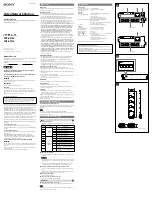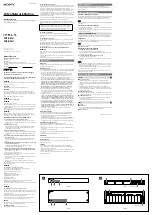
Citation 7.0 Owner’s Manual
Preliminary Draft
Page # 11
Enitre Contents Copyright ©1995 - Harman Kardon Inc.
Surround Mode Explanations
“Movie Modes”
Dolby ProLogic™
This is the consumer version of the system used in theaters to decode four channels of sound from a movie sound
track into separate left, center, right and surround channels. In Dolby ProLogic, the rear channels are a mono signal,
and they are bandwidth limited. ProLogic is always a good starting point when you are selecting a surround mode to
use when listening to a movie or surround encoded broadcast, CD or video game.
70mm
The 70mm mode is a Jim Fosgate design, using ProLogic as a starting point. To increase the excitement level of
surround encoded materials, the 70mm mode uses Citation’s ultra fast decoding logic to deliver extended bandwidth to
the surround channels. Instead of the 7kHz surround cut-off in ProLogic, the rears extend to 12kHz. Although broader
bandwidth surround channels are technically possible, we have selected this cut off in order to preserve the spectral
balance in your listening room. (Too high a frequency range for the surrounds is not advisable due to the fact that you
are located closer to the speakers than you would be in a movie theater’s auditorium.) The audio delay to the rear
channel may be set as high as ??microseconds, although you will probably not want to exceed 25ms. Finally, there is
some controlled blending of the left/right front channel information into the left and right rear channels. This delivers an
increased sense of spaciousness from most soundtracks.
The 70mm mode is ideally suited to use with any recording or broadcast that contains matrix surround encoding.
Home THX
Developed by Lucasfilm, Ltd., Home THX extends the benchmark of Dolby ProLogic to include specialized circuits that
are designed to deliver consistency of reproduction all along the chain of a movie’s soundtrack. Home THX includes
four separate circuits (Re-Equalization™, De-Correlation, Timbre Matching and BiAmplification) that enable you to
more closely match the sound reproduced in your home theater to the way the sound was heard in the mixing room
where it was created, and in the movie theater where you may have first heard it.
Home THX is best suited for use with playback of theatrical movie soundtracks. The movie may be broadcast over the
air, via satellite or on cable, or it may be played back from a laser disc or videocassette. When listening to television
programs such as dramas, sports or musicals that were NOT originally intended for movie theaters, the Home THX
mode may not sound correct, as it contains circuits specifically designed to compensate for the differences between
movie theaters and home environments.
“Music” Modes
Reproducing conventional two channel (unencoded) recordings or broadcasts in a multi-channel audio system has
always been a tremendous challenge. While encoded movie soundtracks include information to direct the processor
as to the location of specific audio signals, non-encoded recordings provide no such clues. Most surround processors
attempt to imitate surround for music through the use of digital soundfield processing (DSP). While technically
ambitious, the use of DSP often results in an artificial sound. DSP generated reverberation and effects may distort the
clarity of the original recording, and some listeners find that the digitization of signals results in a harsh sound that is
not representative of the original recording.
Using Jim Fosgate’s proprietary surround matrix designs, and the newly developed 6 Axis Steering Logic™
technology, the Citation 7.0 overcomes the limitations typically found in DSP. By carefully delaying signals, and
controlling the amount of front channel information mixed into the rear channels, and through the use of other carefully
tuned, proprietary circuits, the 7.0 is able to produce a pleasing multichannel sound from almost any two channel
stereo recording.












































